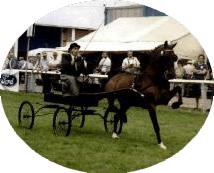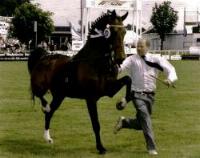|
|
 |
The Hackney
|
The Hackney Horse is an elegant
high stepping breed of carriage horse entirely British bred. It made its
appearance in the 18th century in Yorkshire and Norfolk in the UK and quickly
became the ideal carriage horse of the day - only to be replaced by the motor
car in the 1920's.
Today, Hackney Horses and Ponies are renowned
for their brilliant and extravagant displays of high stepping action in the
show ring. Pulling smart four-wheeled show wagons or immaculate in Private
Drive or Concourse d'Elegance turnouts, they captivate audiences worldwide with
their grace, elegant bearing and lively personality. What many people do not
know is how the Hackney and Hackney Pony evolved from quite humble origins to
become through two centuries of selective breeding, one of the most spectacular
of British breeds.
 |
In the 18th
century, Hackneys were mainly used as dual-purpose nags by farmers, who greatly
valued them for their courage, soundness and endurance. Even then their
reputation as sports horses was growing, and there are many contemporary
reports of their trotting feats, both ridden and driven - 16 miles in an hour
or 60 miles in a day were regular achievements. The famous mare Nonpareil is
reputed to have trotted 100 miles in 9 hours 56 minutes, showing no signs of
fatigue. The sporting gentlemen of the day matched their animals against each
other for considerable amounts of money. |
Hackneys continued to develop through selective
breeding into types suitable for the job in hand. The heavier sort, used mainly
for coach work and remounts for the British Army were also exported for
improving the breeding of European military horses. The smaller, lighter
animals were used for private harness work and sporting activities. In 1866, a
Mr. Wilson from Westmorland used his 14 hand Hackney stallion on a pony mare,
The Pet, said to be a thoroughbred, and the resulting filly was in time put
back to the Hackney stallion. The progeny of these matings formed the
foundations of the Hackney Pony, completing the size range for the breed which
now extends from under 12 to over 16 hands. Hackneys are now exported all over
the world, mainly to improve the breed, but also for show purposes.
Although modern Hackneys may often be regarded as specialised animals, suitable
for their showing role, this is far from the truth. In the driving world as
well as being recognised as the superlative animal for Concours d'Elegance,
Private Driving, Trade and Coaching classes, Hackneys and Hackney cross-breds
compete with great success in the taxing disciplines of Carriage Driving
Trials. They also perform successfully in ridden dressage, eventing and show
jumping. Breeders are once again looking at these remarkable horses when making
plans for the breeding of competition horses and ponies, for the Hackney's
attributes of quality, courage, activity and great strength, qualify him for
serious consideration in the breeding of the modern Sports Horse.
 The information and pictures
on this page are provided by the Hackney Horse Society. For more information
please follow this link to visit the Hackney Horse Society
|


